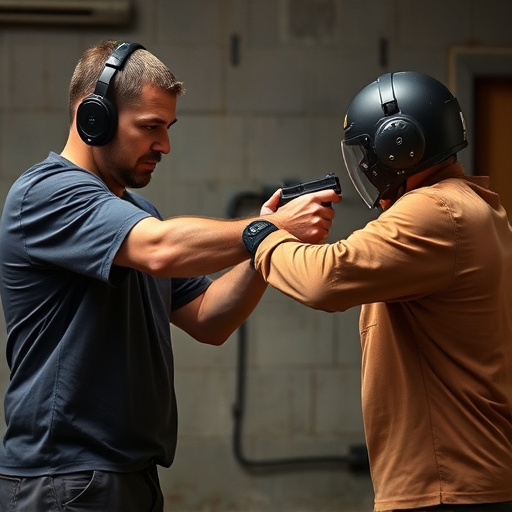Optimal Stun Gun Electrode Spacing: Key to Women’s Self-Defense Power
Optimal electrode spacing on stun guns is crucial for effectiveness in self-defense, particularly fo…….
Optimal electrode spacing on stun guns is crucial for effectiveness in self-defense, particularly for women. Targeting high nerve density areas and maximizing shock distribution ensures quick immobilization of assailants. Women should prioritize models with precise electrode placement, lightweight designs, comfortable grip, and intuitive triggers. The ideal electrode gap is 1.5-2 inches, offering a balance between surface area contact and focused energy delivery. Real-world testing shows that closer spacing improves impact and effectiveness, especially in life-or-death situations. Choosing the best self-defense stun gun involves understanding electrical architecture and current distribution for maximum incapacitation reliability.
In today’s digital era, personal safety is paramount, and stun guns have emerged as a popular choice for self-defense. Understanding the intricate details of stun gun electrode spacing can significantly enhance their effectiveness. This article delves into the optimal placement of electrodes, exploring factors influencing this critical design aspect. We analyze top stun guns tailored for women, dissecting their electrical architectures. Through real-world testing, we assess how electrode spacing impacts performance. Armed with this knowledge, users can make informed decisions when choosing the best self-defense stun gun for women, ensuring maximum protection.
- Understanding Stun Gun Electrode Spacing: Key to Effective Shock Delivery
- Factors Influencing Optimal Electrode Placement for Self-Defense Devices
- A Comprehensive Analysis of Top Stun Guns for Women: Electrode Configuration
- Real-World Testing: Evaluating the Impact of Electrode Spacing on Stun Gun Performance
- Choosing the Best Stun Gun for Personal Safety: Consideration of Electrical Architecture
Understanding Stun Gun Electrode Spacing: Key to Effective Shock Delivery

Understanding Stun Gun Electrode Spacing is paramount when considering the effectiveness of delivering a powerful shock, especially in the context of self-defense tools designed for women. The electrode spacing on a stun gun directly influences how it disrupts the body’s electrical system, rendering the target immobilized. For best results and optimal safety, the electrodes should be positioned to make contact with larger areas of the body, such as the sides, back, or legs—areas with high nerve density.
When choosing a self-defense stun gun, women should look for models that prioritize precise electrode placement. The ideal best self-defense stun gun for women will have electrodes designed to maximize shock distribution, ensuring a quick and effective neutralization of potential attackers. This strategic focus on electrode spacing enhances the overall effectiveness of the device, providing users with increased confidence and peace of mind in potentially dangerous situations.
Factors Influencing Optimal Electrode Placement for Self-Defense Devices

The optimal electrode placement for self-defense devices, like stun guns, is a critical factor in their effectiveness. Several key factors influence this, especially when tailored to best serve women looking for personal protection. Firstly, the size and shape of the target area play a significant role; different body parts require precise electrode positioning for maximum shock delivery. For instance, targeting larger muscle groups like those in the thighs or arms can provide more power and control during self-defense situations.
Additionally, the stun gun’s design and weight distribution are essential considerations. Lightweight models with ergonomic designs allow for better maneuverability, ensuring users can reach hard-to-access areas more easily. This is particularly important for women who may need to use the device in tight spaces or against larger assailants. The placement of electrodes should also account for comfort and ease of use, as a comfortable grip and intuitive trigger mechanism can mean the difference between life and death in a high-stress situation.
A Comprehensive Analysis of Top Stun Guns for Women: Electrode Configuration

When choosing a best self-defense stun gun for women, understanding the electrode configuration is crucial for effectiveness and safety. Top models in this category often feature optimized electrode spacing, designed to deliver a powerful shock with minimal target area. This precision ensures that the stun gun is effective against larger opponents while reducing the risk of accidental discharge on unintended targets.
The ideal electrode spacing varies slightly between manufacturers, but generally ranges from 1.5 to 2 inches apart. This configuration allows for a balanced combination of surface area contact and focused energy delivery. Wider spacing can provide better ground contact, enhancing stability during use, while narrower spacing enables more targeted shocks, particularly useful in close-quarters situations.
Real-World Testing: Evaluating the Impact of Electrode Spacing on Stun Gun Performance

Real-world testing is an essential component in understanding how different electrode spacing affects the performance of a stun gun, especially when considering it as a self-defense tool for women. In these tests, experts and users alike experiment with various models under simulated scenarios to gather data on effectiveness, safety, and ease of use. The results can provide valuable insights into what works best in real-life situations, highlighting the significance of electrode spacing in delivering a powerful yet controlled shock.
For example, some studies have shown that closer electrode spacing enhances the stun gun’s impact by allowing for a more focused delivery of electric current. This is particularly crucial for self-defense scenarios where speed and effectiveness can be matters of life and death. Moreover, these tests often reveal the optimal distance that balances power with precision, ensuring users receive the best self-defense stun gun suited to their needs without causing unintended harm or injuries.
Choosing the Best Stun Gun for Personal Safety: Consideration of Electrical Architecture

When considering the best self-defense stun gun for women—or anyone seeking personal safety—it’s crucial to understand the device’s electrical architecture and electrode spacing. The effectiveness of a stun gun lies not just in its power output, but also in how it delivers the electric shock. Electrodes are responsible for making contact with the target, so their placement and distance apart can significantly impact the stun gun’s performance.
For optimal safety and efficacy, look for stun guns with well-designed electrical architecture that ensures proper current distribution and a wide area of effect. Closer electrode spacing generally improves the device’s ability to incapacitate assailants by delivering a more concentrated electric shock. This is particularly important in self-defense scenarios where quick and reliable disarmament or neutralization is crucial, making the best stun gun for women one that combines power with precise electrode placement for maximum effectiveness.
When selecting a self-defense stun gun, especially designed for women’s personal safety, understanding electrode spacing and its impact on shock delivery is paramount. The ideal electrode configuration ensures maximum effectiveness against attackers, making it a key factor in choosing the best self-defense stun gun. By considering factors like device design, testing results, and electrical architecture, users can make informed decisions, ensuring they have a reliable tool for personal safety. Opting for a stun gun with carefully considered electrode spacing can provide the necessary advantage in potentially dangerous situations.


